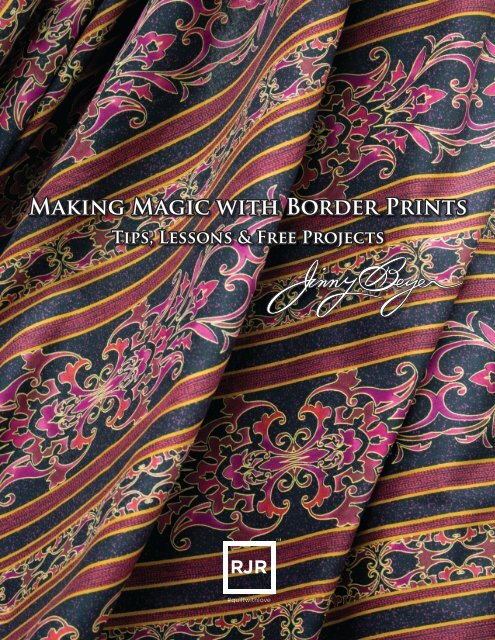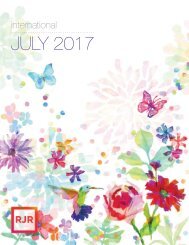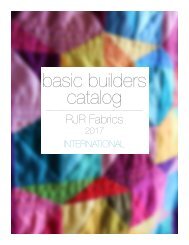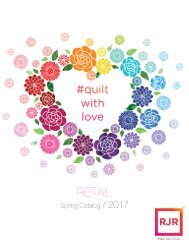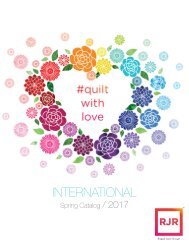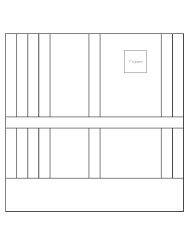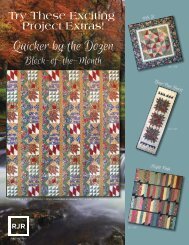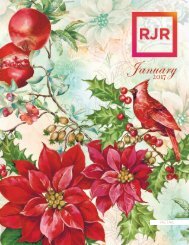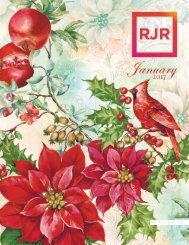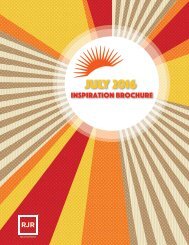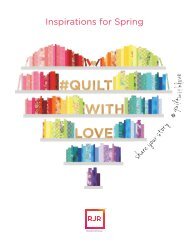Create successful ePaper yourself
Turn your PDF publications into a flip-book with our unique Google optimized e-Paper software.
<strong>Border</strong> Print Fabrics - Making Quilting Magic<br />
B ecoming familiar with Jinny Beyer border print fabrics is a great way to add to your quiltmaking skill<br />
set. Designed specifically for quilters, by a world-renowned fabric and quilt designer, they are easy to use but<br />
provide big impact. This e-book will show you how to put border print fabrics to work.<br />
As high-impact patches<br />
in your quilt blocks<br />
As the only fabric in a block<br />
or the primary one in a quilt<br />
As an elegant, balanced<br />
border for your quilts<br />
Inside you will find gorgeous examples of blocks and<br />
projects using border prints, with tips and techniques<br />
on how to best use these versatile fabrics. Plus there<br />
are free project patterns and tip sheets to download,<br />
and links to videos where Jinny shows you her secrets<br />
to using border print<br />
inspired!<br />
fabrics. Prepare to be<br />
1<br />
Echoes pattern and quilt kits available at jinnybeyer.com and rjrfabrics.com
The Key Characteristics of <strong>Border</strong> Prints<br />
Trust a quilter to design fabric with maximum design potential and minimum waste! With more than thirty<br />
years’ experience, Jinny ensures that every border print fabric she designs has these three characteristics:<br />
1) At least 4 narrow & 4 wide stripes<br />
2) Seam allowance between stripes<br />
Every border print is designed to have at least four<br />
narrow and four wide stripes that run the length of<br />
fabric. Having narrow and wide stripes provides<br />
multiple design options for using them in blocks,<br />
sashings and borders. And with at least four of each<br />
stripe, it’s easy to figure out how much is required to<br />
use them to frame a quilt: take the longest side of the<br />
quilt and add 18" for a square quilt (24" for a<br />
rectangular quilt) for matching the designs at the<br />
corners.<br />
Every fabric is designed with at least ½" between the<br />
wide and narrow stripes. This allows you to cut<br />
between them, maintaining a ¼" seam allowance on<br />
both sides of the stripes! This means you never have<br />
to waste a stripe to use the part you want – you use<br />
every bit of fabric.<br />
3) Fabric designed with mirror images<br />
Watch This!<br />
An Introduction to Jinny Beyer <strong>Border</strong> Print Fabrics<br />
jinnybeyer.com/bordertips<br />
Something wonderful happens when you use fabric<br />
that has mirror-image designs. In these designs, the<br />
left side is a reflection of the right side. Sometimes the<br />
designs reflect top to bottom, too. Fabrics that are<br />
designed in this way open a world of kaleidoscopic<br />
possibilities in patches and blocks.<br />
2
Incorporating <strong>Border</strong>s into Your Blocks & Quilts<br />
S ince the very beginning, quilters have been carefully cutting fabric to feature a particular portion of the<br />
design in their blocks. With their mirror-image designs, border print fabrics are ideal for fussy cutting.<br />
This compass-style<br />
block features<br />
classic fussy cutting.<br />
Eight of the compass<br />
points are cut<br />
from identical<br />
portions of the<br />
border print.<br />
Patchwork of the Crosses<br />
This popular Lucy<br />
Boston block is ideal for<br />
fussy cut border print<br />
patches.<br />
North Carolina Star<br />
Fairfax Crown<br />
The center square in<br />
this block is made from<br />
four identical triangles.<br />
Wishing Star<br />
This block includes two<br />
different patches cut from<br />
portions of the border<br />
print. Look at the<br />
wonderful kaleidoscopic<br />
effects you can create<br />
when you sew identical,<br />
mirror-imaged patches<br />
together!<br />
Use this technique in other shapes too!<br />
Octagons Equilateral Triangles Hexagons<br />
Rising Sun Wonder of Egypt Diamond & Arrows<br />
3
For the biggest impact when fussy cutting borders, keep these tips in mind.<br />
When a patch is repeated<br />
in a block, center<br />
the mirror-image motif<br />
in the patch and cut<br />
identical pieces. As in<br />
the North Carolina Star<br />
block, this gives a<br />
pleasing symmetry and<br />
rhythm to the block.<br />
When multiple<br />
identical patches are<br />
used to form a shape<br />
such as a square,<br />
hexagon, octagon or<br />
triangle, capture a<br />
printed line from the<br />
border print on the<br />
outside edge of the patch. This forms a strong frame around<br />
the unit, as in Fairfax Crown.<br />
<strong>Border</strong> prints can also be used as whole blocks<br />
and entire quilt projects too!<br />
Thousand Pyramids (right) is a great<br />
example of how a project can be<br />
composed entirely of border prints.<br />
Look at the design<br />
possibilities when using<br />
border prints in tumbling<br />
blocks (left), hexagons<br />
(bottom), and triangles.<br />
These are all great shapes to<br />
use with border prints, and<br />
when repeated, can make a<br />
striking allover design.<br />
The Thousand Pyramids and <strong>Border</strong> Print Tumbling Blocks<br />
patterns and quilt kits are available at jinnybeyer.com<br />
Watch This!<br />
Check out Jinny’s video, Magical Effects with<br />
<strong>Border</strong> Print Fabrics www.jinnybeyer.com/bordertips<br />
41
Making a <strong>Border</strong> Print Square<br />
J ust as you can replace individual patches in a quilt block with border print fabric, you can make whole<br />
blocks – or even whole projects – out of border prints. The process is the same, but the pieces are bigger!<br />
1) Make the template.<br />
Determine the finished size of the square. Draw the square on paper, then<br />
divide it into four triangles by marking two lines, corner to corner.<br />
Place see-through plastic on top of one of the triangles and trace a dashed<br />
line around it. This will be the finished size of the triangle. Next, draw lines<br />
¼" outside the dotted lines to add seam allowance. Cut out the triangle<br />
template on these solid lines.<br />
Mark the mirror line down the very center of the template, and add a<br />
grainline arrow near the base of the triangle.<br />
2) Center the template on one of the mirror-image<br />
motifs on the fabric.<br />
Use the mirror line as a guide. Adjust the template so the outside edge of the<br />
stripe is just inside the dashed line at the base of the triangle. Mark a portion<br />
of the fabric design on the template to use as a guide for cutting out the<br />
remaining identical pieces. Mark around the template and cut the piece out.<br />
3) Use the template to cut three additional triangles<br />
that are identical to the first .<br />
Pin the triangles together in pairs, carefully matching the fabric design, then<br />
sew them together. Sew the two pairs together to complete the border print<br />
square. Simply position the template on different portions of the fabric.<br />
5
One border print can produce a myriad of designs.<br />
Simply position the template on different portions of the fabric.<br />
6
Framing a Square Quilt the Jinny Beyer Way<br />
B order stripes have been used to frame quilts and bed linens for centuries. Jinny has perfected the art of<br />
framing a quilt with border print fabric, so the designs match perfectly at the corners. And with her<br />
technique, there’s no math involved! Simply follow the steps below.<br />
1) Mark & cut the first border strip.<br />
Place a strip of border print across the middle of the quilt, centering a<br />
motif from the border at the exact center of the quilt. To mark the first<br />
miter, position a quilter’s ruler so the 45° angle runs along the bottom<br />
edge of the border print and the ruler touches the point where the top<br />
edge of the border print meets the edge of the quilt. Mark, then cut<br />
the miter line.<br />
45° line<br />
2) Miter each edge.<br />
Use the mitered edge as a pattern for the other side of the strip. Bring<br />
the mitered side of the border strip to the opposite side of the quilt,<br />
folding the strip over itself, right sides together. Place the top edge of<br />
miter at the edge of the quilt, adjusting it a bit if necessary so that the<br />
design motifs on the top and bottom match exactly. Mark and cut this<br />
second miter.<br />
3) Cut the remaining border strips.<br />
Using this cut strip as a pattern, cut three more identical<br />
strips, matching the fabric designs exactly.<br />
4) Mark the seam intersections.<br />
Mark the seam intersection points on the short side of each of your<br />
border strips. To find the points, simply draw a short line ¼" inside<br />
the mitered edge and the short edge of the border strip. Make a dot<br />
where the two lines intersect. Do the same for each corner of your<br />
quilt. Marking these dots will help you achieve perfect miters!<br />
7
5) Sew the borders to the quilt.<br />
Pin the mid-point of one of the border pieces to the middle of one of<br />
the edges of the quilt. Next, match and pin the dots on each side of<br />
your border with the dots on the quilt corners. Continue pinning the<br />
border to the quilt, easing in any fullness. Sew the border to the quilt,<br />
starting and stopping at the dots, and locking your stitches. Do not sew<br />
past the dots into the seam allowance! Repeat for the remaining three<br />
borders.<br />
6) Sew the miters.<br />
At one corner, pin the borders together, matching<br />
the fabric designs. Begin stitching from the inside<br />
dot towards the edge of the border. Lock your<br />
stitches at the beginning and end. Repeat for the<br />
remaining three borders.<br />
Get more details on this technique – plus<br />
instructions on framing a rectangular quilt and<br />
applying multiple borders at<br />
jinnybeyer.com/bordertips<br />
Watch This!<br />
Watch Jinny demonstrate her no-math border<br />
technique in Framing a Quilt with <strong>Border</strong> Print Fabric<br />
www.jinnybeyer.com/bordertips<br />
8
Putting it all Together<br />
J o celebrate her latest collection of border print fabrics, Jinny has created a brand new quilt.<br />
Explore the three main border print techniques with High Tea<br />
• Fussy cuting border print patches in blocks<br />
• Using border prints as alternating blocks<br />
• Framing a quilt with border print<br />
Blue/gold colorway<br />
The High Tea pattern is available in two colorways for download at<br />
jinnybeyer.com/borderprojects and rjrfabrics.com<br />
9
Try These Inspirational and Free Projects<br />
Cosmos<br />
<strong>Border</strong> Print Place Mat<br />
Cosmos is Jinny’s <strong>2016</strong> BOM quilt – it features a border print<br />
in the quilt blocks, sashing and borders. The pattern is free to<br />
Jinny’s newsletter subscribers. For more information or to<br />
subscribe, visit www.jinnybeyer.com/subscribe<br />
Made from just six pieces, the <strong>Border</strong> Print Place Mat<br />
is cut from a half-yard of border print fabric. You can<br />
vary the look by changing which portion of the fabric<br />
design you use. Any border print fabric will work, so<br />
choose your favorite and make a set. There’s even<br />
instructions for a table runner variation! The pattern is<br />
a free download at jinnybeyer.com<br />
Medallion Table Runner<br />
This lovely table runner features a center medallion made from border print, plus braided strips of<br />
beautifully coordinated fabrics. The pattern is a free download at jinnybeyer.com and rjrfabrics.com<br />
10
"In creating my newest <strong>Border</strong> <strong>Basics</strong> Collection, I focused on versatility in both<br />
design and color. The border prints are set in different scales to fit projects in a variety<br />
of sizes, and include multicolor and tone-on-tone options – perfect for projects for<br />
every occasion and every season."<br />
To see a full collection of Jinny Beyer's <strong>Border</strong> <strong>Basics</strong>, visit www.rjrfabrics.com.


